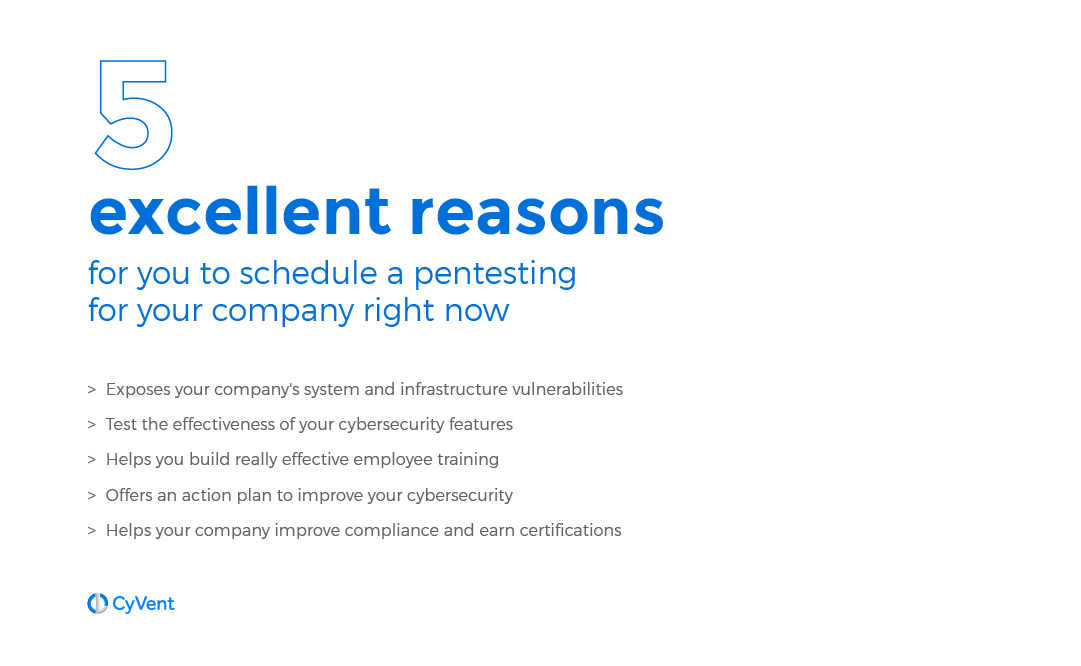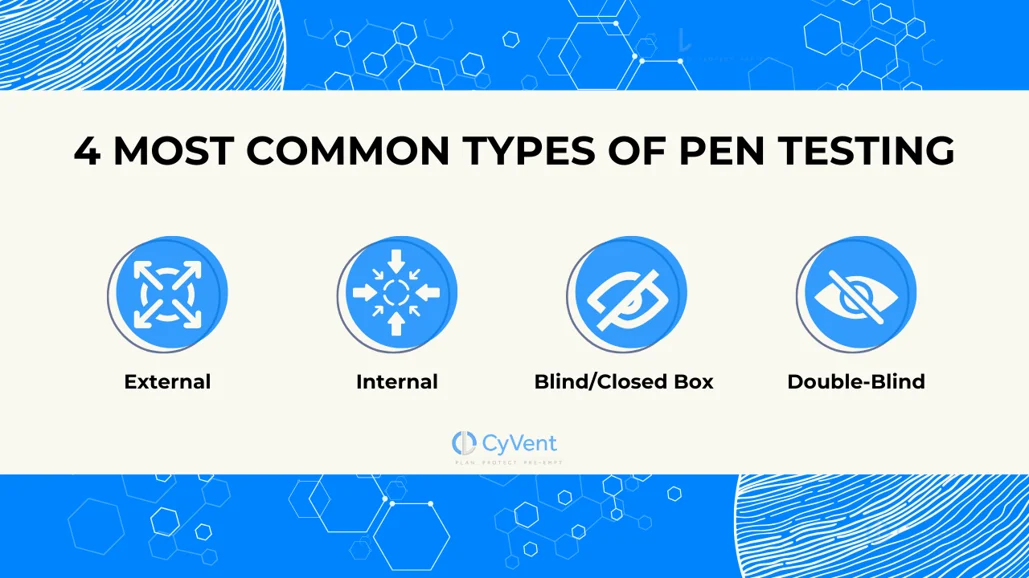
The Ultimate Pentesting Guide: The #1 Way To Expose Your Cybersecurity Weaknesses
You invest in cybersecurity tools, train your employees, and establish habits that protect your business data from hackers. But is that enough? Will your company survive when it faces a cyberattack? The penetration test has the answer.
The penetration test, also known as Pentest, is a training method that simulates an invasion of the company's systems. It ensures that the company covers all gaps before it's too late.
According to the 2020 Penetration Testing Report, only 3% of companies believe that penetration testing is not important to their security posture.
In this article, we'll walk you through everything you need to know when performing pen testing, including:
Why Having a Pentest Is Important For Your Company?
5 Excellent Reasons For You To Schedule a Pen Test For Your Company Right Now
The 4 Most Common Types of Pen testing
Who Should Run The Penetration Test?
What Is The Difference Between a Penetration Test And a Vulnerability Scan?
What Happens After the Pentest?
What is Penetration Testing?

Penetration testing, often referred to as pen testing or ethical hacking, is a proactive approach to cybersecurity. It involves simulating cyber attacks on a computer system, network, or web application to evaluate its security. The primary goal of penetration testing is to uncover security weaknesses and vulnerabilities that could be exploited by malicious actors to gain unauthorized access to sensitive data or disrupt system functionality. By identifying these vulnerabilities, organizations can strengthen their security posture and prevent potential breaches before they occur.
Why Having a Pentest Is Important For Your Company?
The National Institute of Standards and Technology (NIST) defines the Penetration Test as: “A method of testing where testers target individual binary components or the application as a whole to determine whether intra or intercomponent vulnerabilities can be exploited to compromise the application, its data, or its environmental resources.”
In simple terms, the pentest highlights the company’s cybersecurity weaknesses and uncovers security vulnerabilities that need to be corrected.
According to The State of Pen testing 2022, these are the 5 most frequently discovered vulnerability categories found in 2021: 1. Server Security Misconfigurations: 38% 2. Cross-Site Scripting (XSS): 13% 3. Broken Access Control: 11% 4. Sensitive Data Exposure: 10% 5. Authentication and Sessions: 8%
In this way, pen testing allows the security team and also the IT team to have clarity on the weaknesses of the infrastructure. As a result, professionals can act quickly to address vulnerabilities, according to priorities.
In addition to helping with the structural issue, this type of method also allows testing the company’s ability to inform the team of the existence of a threat and also to score the team’s response to the incident.
5 Excellent Reasons For You To Schedule a Pen Test For Your Company Right Now

1. Exposes Your Company's System And Infrastructure Vulnerabilities
Through penetration testing, hackers identify vulnerabilities in the infrastructure and also in the system settings. A penetration tester simulates cyber attacks to identify these vulnerabilities and assess the security measures in place. This includes not only technical issues but also user habits, which could be creating breaches for intruders to enter.
2. Test The Effectiveness Of Your Cybersecurity Features
Often, the company is confident that its cybersecurity investments are enough. However, this is not always true. The penetration test evaluates security barriers and acts as a black hat hacker would.
Plus, it helps you test whether your Incident Response Plan measures up to combat a real threat.
In this blog post, we have gathered 6 important elements to check before finalizing your Incident Response Plan.
3. Helps You Build Really Effective Employee Training
Pentest puts your company's employees in a risky situation. Pentest assesses employee response to social engineering, including phishing and business email compromise attacks.
According to the Cost of a Data Breach Report 2022, the most common initial attack vectors were compromised credentials at 19% of breaches, followed by phishing at 16% of breaches. The average cost of data breach with a phishing initial attack vector is USD 4.91 million. Testing your employees' responses helps directors identify which behaviors should be improved and which processes need to be polished for the result to be positive.
Going through this experience also sensitizes employees, improving engagement in training.
4. Helps Your Company Improve Compliance And Earn Certifications
Cybersecurity is increasingly an important criterion for closing deals. The positive result of a penetration test can be part of your compliance program and also the achievement of important certifications, such as the ISO 27001 standard and the PCI regulations.
5. Offers An Action Plan To Improve Your Cybersecurity
After carrying out a penetration test, the company receives a complete report with all the vulnerabilities found, all the errors that must be corrected, and the elements that can be improved, in the hardware and the software. All this is accompanied by an in-depth and specialized analysis, with recommendations that will effectively improve the company's barriers against cyberattacks.
A consistent pentest considers ALL vulnerabilities. As Window Snyder states, “One single vulnerability is all an attacker needs”.

The Penetration Testing Process
The penetration testing process is methodical and involves several critical phases:
Reconnaissance: This initial phase involves gathering as much information as possible about the target system. Penetration testers collect data such as IP addresses, domain names, and network topology to understand the target’s structure and potential entry points.
Scanning: In this phase, testers use tools like Nmap and Nessus to identify open ports, services, and vulnerabilities within the target system. This step helps in mapping out the attack surface.
Gaining Access: Here, testers exploit the identified vulnerabilities to gain unauthorized access to the target system. This phase demonstrates how an attacker could breach the system and what data or functionalities they could compromise.
Maintaining Access: Once access is gained, testers attempt to maintain their presence within the system to gather more information or escalate their privileges. This phase simulates how attackers might persist in a compromised environment.
Covering Tracks: Finally, testers cover their tracks to avoid detection. This step is crucial for understanding how attackers might hide their activities and evade security measures.
The 4 Most Common Types of Pen testing

There are different types of penetration tests that can be performed. Below, we list 4 main ones:
1. External Pen Test
In this type of test, ethical hackers, together with an experienced cybersecurity team, are hired by the company to perform the penetration test focusing on the website and network servers that are external to the company.
2. Internal Pen Test
This test involves exercises that start from the company's internal network. It starts from the access of an internal person to the company, such as an employee, to simulate an internal threat.
3. Blind Pen Test Or Closed-Box Pen Test
In this test, the hacker performing the exercise does not receive any information about the company other than his name. To carry out the invasion, the professional seeks data from open sources. However, the company is aware of the pen testing.
4. Double-Blind Pen Test
This test is a more advanced version of the Blind Pen Test. In this case, in addition to the hacker not having any information about the organization, almost no one in the company knows that the test is being carried out. In this way, the exercise really assesses the internal capabilities to respond to a threat.
Penetration Testing Tools and Techniques

Penetration testers employ a variety of tools and techniques to simulate cyber attacks effectively. Some of the most commonly used tools include:
Nmap: A powerful network scanning tool that helps identify open ports and services on a target system.
Metasploit: A comprehensive penetration testing framework that allows testers to exploit vulnerabilities and gain access to target systems.
Burp Suite: A versatile web application security testing tool used to identify vulnerabilities such as SQL injection and cross-site scripting (XSS) in web applications.
Social Engineering Toolkit (SET): A tool designed to simulate social engineering attacks, including phishing and spear phishing, to test human vulnerabilities.
Best Practices for Penetration Testing
To ensure penetration testing is effective and yields valuable insights, organizations should adhere to best practices, including:
Conducting Regular Penetration Tests: Regular testing helps identify and address vulnerabilities before they can be exploited by attackers.
Using a Variety of Testing Methods: Combining manual and automated testing methods ensures a comprehensive assessment of all potential vulnerabilities.
Testing for Social Engineering: Including social engineering penetration testing helps identify weaknesses in human behavior that could be exploited by attackers.
Providing Training and Awareness: Educating employees about cybersecurity threats and best practices helps prevent social engineering attacks and improves the overall security posture.
Penetration Testing for Cloud and Application Security

Penetration testing is crucial for ensuring the security of cloud-based systems and applications. This specialized form of testing involves simulating cyber attacks to identify vulnerabilities and weaknesses specific to cloud environments and applications. Key techniques include:
Cloud Security Testing: Assessing cloud-based systems and applications for vulnerabilities that could be exploited by attackers.
Web Application Security Testing: Evaluating web applications for common vulnerabilities such as SQL injection and cross-site scripting (XSS).
API Security Testing: Testing APIs for weaknesses in authentication and authorization mechanisms that could be exploited.
Container Security Testing: Assessing containerized applications, such as those using Docker and Kubernetes, for vulnerabilities that could compromise the container environment.
By following these practices and leveraging specialized tools and techniques, organizations can significantly enhance their cybersecurity defenses and protect their sensitive data from potential breaches.
Who Should Run The Penetration Test?
When the company has an internal cybersecurity team, it is common for the internal penetration tester to carry out periodic tests to identify the effectiveness of security policies. However, the ideal way to carry out this procedure is by an external team, which does not know the internal processes of the company.
Find out more about the Penetration Test here
The team is usually composed of “ethical hackers”. Experienced professionals, who think like cybercriminals and are able to look for blind spots in company cybersecurity.
Despite its importance, a recent survey revealed that 88% of businesses review security risks on their own, rather than using a vulnerability management solution.
What Is The Difference Between a Penetration Test And a Vulnerability Scan?
Vulnerability scanning is widely used to verify the security level of an institution. It scans your systems and IT infrastructure thoroughly, identifying any known security vulnerabilities and reporting their level of criticality.
Pentest does a similar job. However, through a team of ethical hackers, it is possible to put these vulnerabilities to the test and identify how far a hacker can go within the current context.
These two features must be used together to ensure that the company has good cybersecurity backing.
How Often Should Penetration Tests Be Performed?

As seen above, vulnerability scanning is a complementary test to pen testing. It has the advantage that it can be automated, which allows it to be carried out more frequently. Scanning can be done daily or weekly, for example.
The penetration test, on the other hand, needs more preparation time, as it involves hiring a specialized team.
There is no ideal frequency for performing the penetration test. This will depend on the characteristics of the company, its size, and its available budget. The ideal is to get the support of a specialized security consultant, who will assess the business and identify the ideal frequency.
In addition to periodic tests, it is recommended to carry out a new process every time there is a considerable change in the company. For example change of physical address, hiring new employees, software change, relevant software, and infrastructure upgrades.
Regulations and certifications related to the company's sector must also be taken into account. Some organizations must follow specific standards for performing security tests.
An interesting aspect of the penetration test is that it doesn't have to be done on a large scale. It is possible to perform focused tests more frequently, in areas that the company deems to be more critical. While broad and comprehensive testing is performed annually, testing focused on priority areas can be done every quarter, for example.
Retaking the test is also important. After testing and fixing the most critical vulnerabilities, it is common to carry out a new exercise to ensure that the changes were sufficient. This test is usually more agile and quick. There are tools that help in its conduct, identifying the most critical points pointed out in the previous report.
What Happens After the Pentest?
What happens after the penetration test is more important than the test itself. The professionals involved in the test prepare a report with all the findings and also an action plan that includes the next priority steps. The company needs to take the findings and recommendations seriously.
The security and development team need to work together to fix the vulnerabilities.
The State of Pen testing 2022 reveals that the median number of days teams needed to fix vulnerabilities is 14, but there are situations where they take 31 days or longer. However, the study also reveals that teams are struggling to fix and prevent the same vulnerabilities for at least the past 5 years in a row.
The most critical changes should be prioritized, but low-risk vulnerabilities should not be overlooked.
Employee training should also be updated according to perceived vulnerabilities in relation to the human risk factor.
Conclusion
Performing penetration tests within the company offers fundamental self-knowledge for the organization. With reporting data, security and development professionals can identify the highest-priority vulnerabilities.
In this article, we have highlighted the importance of pen testing, the 4 main types of penetration tests, who should perform the exercise, the difference between pen testing and vulnerability scan and also what should be done after the penetration test.
Need help testing your cybersecurity?
Do you need help running a penetration test in your company? CyVent and 24by7 offer Penetration Testing Services.
Our experts are on hand to help you with:
In-depth penetration testing, including black box, gray box, and white box tests
Verification of overall security posture, including assessments of your network, wireless network, and cloud environment
Assessment of employee response to social engineering, including phishing and business email compromise attacks
Identification of potential vulnerabilities to ensure compliance and reduce operational and reputational risks
If you want more information, book a call on https://www.cyvent.com/assess-company-cyber-threats/



